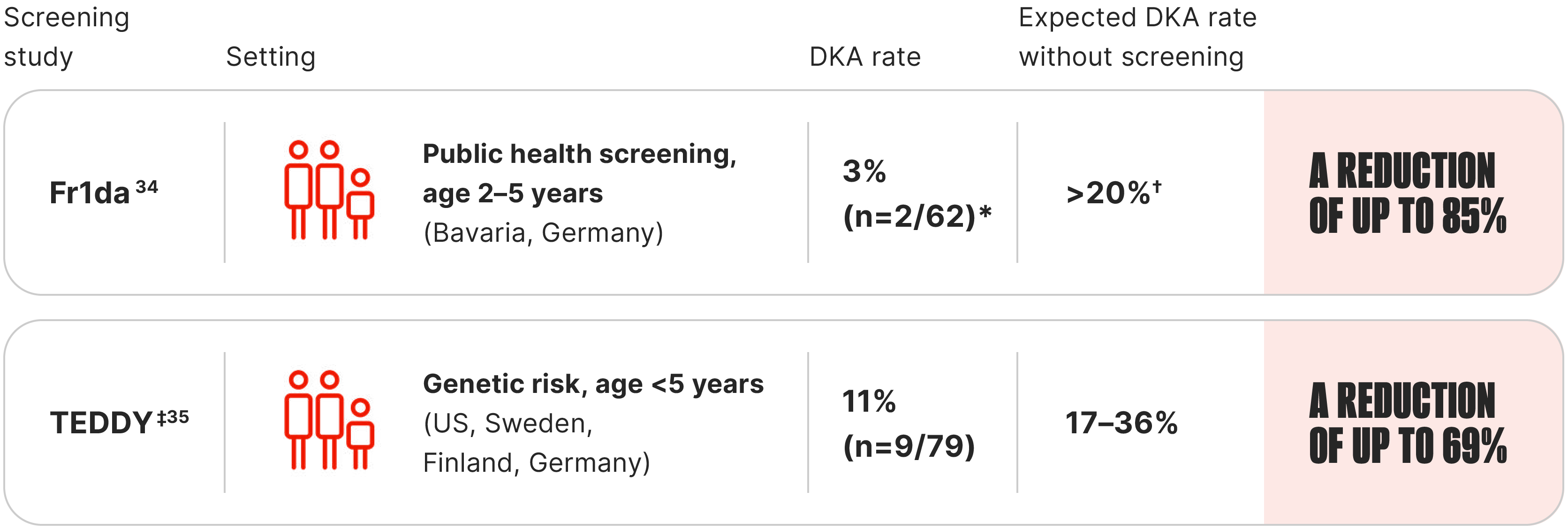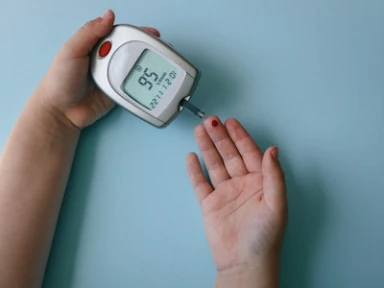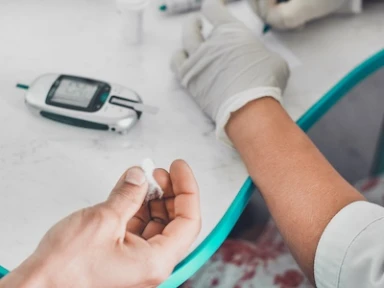Why to screen for Autoimmune T1D


WHY TO SCREEN
Proactive screening reduces the likelihood of a medical emergency and enables a smoother transition to life with Stage 3 autoimmune T1D.7,8,27,28
SCREENING AND MONITORING PROGRAMMES CAN REDUCE RATES OF DKA BY UP TO APPROXIMATELY 90%, PREVENTING SEVERE COMPLICATIONS AND REDUCING HOSPITALISATION27
Studies show that screening can lower rates of DKA at onset of Stage 3 autoimmune T1D.34–40
High reductions of DKA rates were observed in the following studies:

DKA, diabetic ketoacidosis; HLA, human leukocyte antigen; T1D, type 1 diabetes; TEDDY, The Environmental Determinants of Diabetes in the Young; US, United States.
*Public health screening that screened 90,632 children for autoimmune T1D islet autoantibodies in Bavaria, Germany, of the 62 children with presymptomatic autoimmune T1D who developed Stage 3 of the condition, 2 (3.2%) were diagnosed in the laboratory with mild or moderate DKA without clinical symptoms, while 60 (96.8%) did not have DKA.34 †The previously reported prevalence of DKA in unscreened children is over 20% in Germany.34
‡A study that screened 424,788 children for autoimmune T1D HLA risk at birth and enrolled 8,677 children between 2004 and 2010. Of those children aged <5 years at autoimmune T1D diagnosis, 9 of 79 (11%) experienced DKA at diagnosis.35
ENABLE A SMOOTHER TRANSITION INTO LIFE WITH AUTOIMMUNE T1D7,8,27,28,47,48
An abrupt Stage 3 autoimmune T1D diagnosis can feel like a crash-landing for individuals and their families.49,50
.png/jcr:content/Asset%202@2x%20(1).png)
.png)
Early detection of autoimmune T1D through screening creates a valuable window for proactive education and support.7,8,27,28,47,48
“If you take care of yourself, you don’t wait for something to happen to you. It’s hard to get through that trauma [of diagnosis], not only physically but mentally too. If you can anticipate it, it’s important and better for your body and your health.”
Alizée,
Real person living with autoimmune T1D
.png/jcr:content/Asset%204@2x%20(1).png)
.png)
High HbA1c levels are linked to greater diabetes distress.*51 Individuals diagnosed via screening in the condition’s presymptomatic stages show lower HbA1c levels at Stage 3.28
“It gives myself and my wife a lot of peace to know and some calm; we’ve got this covered. There’s usually some calm, comfort and peace that comes with doing the screening.”
Korey,
Real person living with autoimmune T1D and parent


Children who are diagnosed with autoimmune T1D through screening before symptoms start tend to have lower HbA1c levels and fewer DKA events at Stage 3 vs those not screened.28
“She had serious ketoacidosis... she was breathing too hard, she wouldn’t open her eyes anymore, so we ran to the hospital. Valeria was basically in a coma when she got there.”
Ana,
Caring for her child living with autoimmune T1D

.png)
The provision of quality, individualised education for families with children diagnosed with Stage 1 or 2 autoimmune T1D improves quality of life and lowers parental stress at Stage 3 onset.†47
“When you are educated, it can take less time to be autonomous. Autonomy when you have type 1 is really important.”
Aïcha,
Real person living with autoimmune T1D
DKA, diabetic ketoacidosis; T1D, type 1 diabetes.
*Diabetes distress refers to the emotional burden and stress resulting from the ongoing demands of managing diabetes daily.51 †Qualitative studies reveal that while maternal anxiety levels initially spike after learning of their child’s high-risk status, this anxiety typically subsides to normal levels within 4–12 months.48
- DiMeglio LA, Evans-Molina C, Oram RA. Lancet. 2018;391(10138):2449-246.
- Gregory GA, Robinson TIG, Linklater SE, et al. Lancet Diabetes Endocrinol. 2022;10(10):741-760.
- Wolfsdorf JI, Glaser N, Agus M, et al. Pediatr Diabetes. 2018;19(Suppl 27):155-177.
- Phillip M, Achenbach P, Addala A, et al. Diabetes Care. 2024;47(8):1276-1298.
- Marré ML, James EA, Piganelli JD. Front Cell Dev Biol. 2015;3:67.
- Insel RA, Dunne JL, Atkinson MA, et al. Diabetes Care. 2015;38(10):1964-1974.
- Sims EK, Besser REJ, Dayan C, et al. Diabetes. 2022;71(4):610-623.
- Narendran P. Diabetologia. 2019;62(1):24-27.
- Raab J, Haupt F, Scholz M, et al. BMJ Open. 2016;6(5):e011144.
- Ziegler AG, Rewers M, Simell O, et al. JAMA. 2013;309(23):2473-2479.
- Barker JM. J Clin Endocrinol Metab. 2006;91(4):1210-1217.
- Głowińska-Olszewska B, Szabłowski M, Panas P, et al. Front Endocrinol (Lausanne). 2020;11:476.
- Ludvigsson JF, Ludvigsson J, Ekbom A, et al. Diabetes Care. 2006;29(11):2483-2488.
- Skov J, Kuja-Halkola R, Magnusson PKE, et al. Eur J Endocrinol. 2022;186(6):677-685.
- Biondi B, Kahaly GJ, Robertson RP. Endocr Rev. 2019;40(3):789-824.
- Cárdenas-Roldán J, Rojas-Villarraga A, Anaya JM. BMC Med. 2013;11:73.
- Karges B, Prinz N, Placzek K, et al. Diabetes Care. 2021;44(5):1116-1124.
- Besser REJ, Bell KJ, Couper JJ, et al. Pediatr Diabetes. 2022;23(8):1175-1187.
- Morran MP, Vonberg A, Khadra A, et al. Mol Aspects Med. 2015;42:42-60.
- Muñoz C, Floreen A, Garey C, et al. Clin Diabetes. 2019;37(3):276-281.
- Allen LA, Taylor PN, Gillespie KM, et al. Lancet Diabetes Endocrinol. 2023;11(10):755-767.
- Weires MB, Tausch B, Haug PJ, et al. Exp Clin Endocrinol Diabetes. 2007;115(10):634-640.
- Parkkola A, Härkönen T, Ryhänen SJ, et al. Diabetes Care. 2013;36(2):348-354.
- Allen C, Palta M, D’Alessio DJ. Diabetes. 1991;40(7):831-836.
- American Diabetes Association. Genetics of diabetes. Accessed October 1, 2024. https://diabetes.org/about-diabetes/genetics-diabetes
- el-Hashimy M, Angelico MC, Martin BC, et al. Diabetes. 1995;44(3):295-299.
- Besser REJ, Ng SM, Gregory JW, et al. Arch Dis Child. 2022;107(9):790-795.
- Hummel S, Carl J, Friedl N, et al. Diabetologia. 2023;66(9):1633-1642.
- Tomic D, Craig ME, Magliano DJ, et al. Diabet Med. 2024;41(1):e15218.
- AbuHammad GAR, Naser AY, Hassouneh LKM. BMC Endocr Disord. 2023;23(1):102.
- Cameron FJ, Scratch SE, Nadebaum C, et al. Diabetes Care. 2014;37(6):1554-1562.
- Ghetti S, Kuppermann N, Rewers A, et al. Diabetes Care. 2020;43(11):2768-2775.
- Duca LM, Wang B, Rewers M, et al. Diabetes Care. 2017;40(9):1249-1255.
- Ziegler AG, Kick K, Bonifacio E, et al. JAMA. 2020;323(4):339-351.
- Elding Larsson H, Vehik K, Bell R, et al. Diabetes Care. 2011;34(11):2347-2352.
- Hekkala AM, Ilonen J, Toppari J, et al. Pediatr Diabetes. 2018;19(2):314-319.
- Winkler C, Schober E, Ziegler AG, et al. Pediatr Diabetes. 2012;13(4):308-313.
- Nakhla M, Cuthbertson D, Becker DJ, et al. JAMA Pediatr. 2021;175(5):518-520.
- TRIGR Study Group. Pediatr Diabetes. 2007;8(3):117-137.
- Barker JM, Goehrig SH, Barriga K, et al; DAISY study. Diabetes Care. 2004;27(6):1399-1404.
- Veijola R, Koskinen M, Helminen O, et al. Pediatr Diabetes. 2016;17(Suppl 22):25-30.
- Martinez MM, Spiliopoulos L, Salami F, et al. Clin Diabetes Endocrinol. 2022;7(1):23.
- Sousa GR, Pober D, Galderisi A, et al. Circulation. 2019;139(6):730-743.
- Zakir M, Ahuja N, Surksha MA, et al. Cureus. 2023;15(9):e45835.
- Fowler MJ. Clin Diabetes. 2008;26(2):77-82.
- Rawshani A, Sattar N, Franzén S, et al. Lancet. 2018;392(10146):477-486.
- Moore DJ, Leibel NI, Polonsky W, et al. Int J Gen Med. 2024;17:3003-3014.
- Quinn LM, Rashid R, Narendran P, et al. Br J Gen Pract. 2022;73(726):36-39.
- Rikos N, Mpalaskas A, Fragiadaki M, et al. Nurs Rep. 2022;12(3):564-573.
- Jönsson L, Lundqvist P, Tiberg I, et al. Scand J Caring Sci. 2015;29(1):126-135.
- Diabetes and emotional health - Chapter 3: Diabetes distress. Accessed October 1, 2024. https://professional.diabetes.org/sites/default/files/media/ada_mental_health_workbook_ chapter_3.pdf
- Ospelt E, Hardison H, Rioles N, et al. Clin Diabetes. 2024;42(1):17-26.
- AsktheExperts. T1D info for providers. Accessed October 1, 2024. https://asktheexperts.org/ for-providers
- Edelman S. J Fam Pract. 2023;72(Suppl 6):S19-S24.
- Juvenile Diabetes Research Foundation. New guidance sets out how to support people with early- stage type 1 diabetes. Published June 2024. Accessed October 1, 2024. https://jdrf.org.uk/ news/new-guidance-sets-out-how-to-support-people-with-early-stage-type-1-diabetes/
- ElSayed NA, Aleppo G, Aroda VR, et al. Diabetes Care. 2023;46(Suppl 1):S19-S40.
- Krischer JP; Type 1 Diabetes TrialNet Study Group. Diabetologia. 2013;56(9):1919-1924.
- Hope SV, Wienand-Barnett S, Shepherd M, et al. Br J Gen Pract. 2016;66(646):e315-322.
- Type 1 Diabetes Index. T1D Index factsheet: GLOBAL. Accessed October 1, 2024. https://t1dindex.shinyapps.io/dashboard/
- Type 1 Diabetes Index. A campaign guide to launch the T1D Index. Accessed October 1, 2024. https://www.t1dindex.org/wp-content/uploads/2022/09/Campaign-Guide.pptx-2.pdf
- Sims EK, Besser REJ, Dayan C, et al. Screening for type 1 diabetes in the general population: A Status Report and Perspective. Diabetes. 2022;71(4):610-623.
- Narendran P. Screening for type 1 diabetes: are we nearly there yet? Diabetologia. 2019;62(1):24-27.
- DiMeglio LA, Evans-Molina C and Oram RA. Type 1 diabetes. Lancet. 2018;391(10138):2449-2462.
- Ospelt E, Hardison H, Rioles N, et al. Understanding Providers’ Readiness and Attitudes Toward Autoantibody Screening: A Mixed-Methods Study. Clin Diabetes. 2024;42(1):17-26.
- ElSayed NA, Aleppo G, Aroda VR, et al. Addendum. 2. Classification and diagnosis of diabetes: Standards of Care in Diabetes-2023. Diabetes Care. 2023;46(Suppl 1):S19-S40.
- Ha J, Cree-Green M, Chung ST, et al. Editorial: Metabolic estimates during glucose challenge tests and continuous glucose monitoring-Innovative and broad approaches to assessing glucose and insulin metabolism in diverse populations. Front Physiol. 2022;13:1112502.



